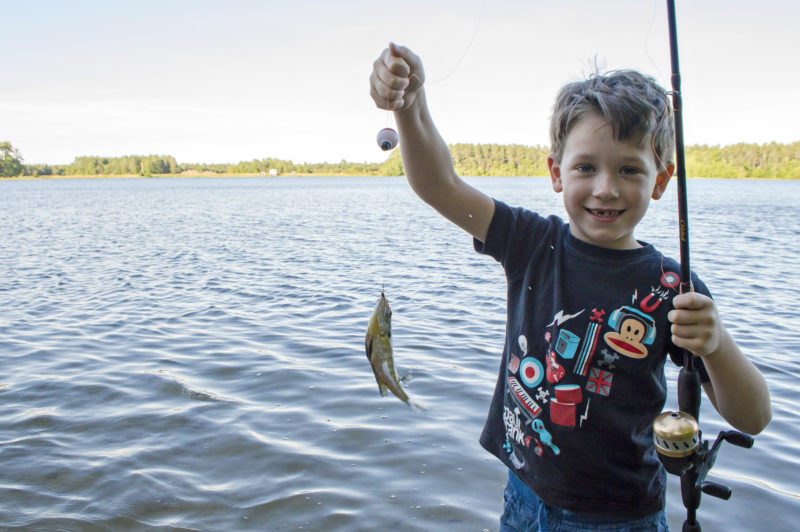How to take your kids freshwater fishing around Buzzards Bay
Many an angler will tell you that they fell in love with the sport of fishing from a young age. With a variety of habitats to explore, the area around Buzzards Bay is a perfect spot to get your kids accustomed to safe, responsible, and fun freshwater angling, too! Whether from a boat or pier, on a marsh, pond, or river, fishing the fresh waters of Southeastern Massachusetts is sure to have you and your kids hooked.
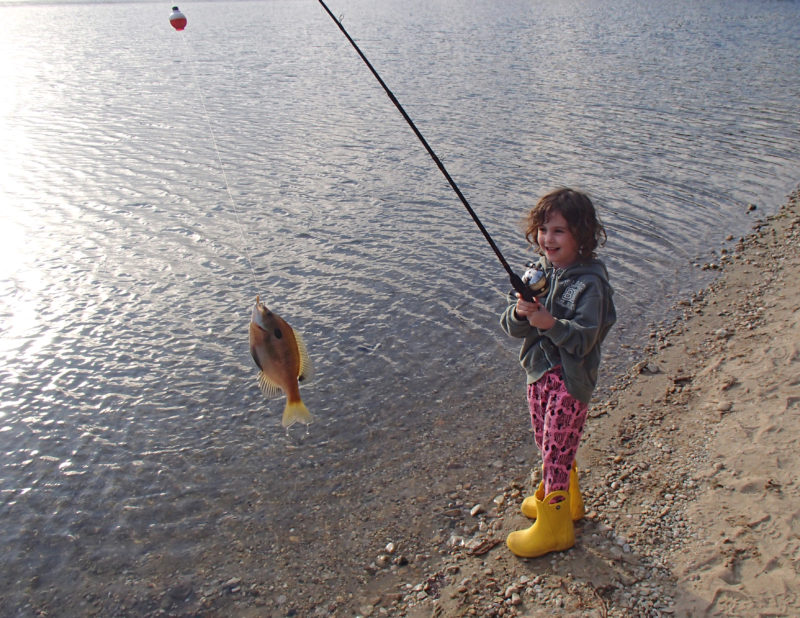
Freshwater fishing on Buzzards Bay’s ponds and streams is fun and easy for the whole family to enjoy!
In addition to its 192 miles of coastline, 2,754 square miles of the state of Massachusetts is fresh or brackish water — and the area around Buzzards Bay is no exception. This region is rich with salt marshes, ponds, and rivers filled with different species open to fishing throughout the year.
What do we need to know to go freshwater fishing?
Before baiting your hook or setting your line, all fishermen in Massachusetts over the age of 15 must have a state freshwater fishing license. Good news for family fishermen: kids under 15 don’t require a license, and licenses for residents ages 15-17 are free!
Once you and your kids are licensed, it’s time to gear up. One of the best things about freshwater fishing is that expensive gear isn’t necessary to have a great time. Many brands sell lightweight, kid-friendly fishing poles that can teach kids proper technique or prevent tangling, but kids can have just as much fun with fishing line tied to a stick on one end and a small hook on the other.
If your child is completely new to fishing, its best to go over a few safety precautions with them, such as keeping little hands away from the hook and informing an adult if they’ve caught something that they need help removing.
Kids should also be comfortable with a sidearm cast, which is more controlled than an overhead cast and takes only 3 easy steps:
- Check over your shoulder that no one is behind or next to you.
- While holding onto the fishing line, slowly sweep the rod from directly in front of you to your side, like you’re opening a door.
- Swing the rod forward, and release your line when the rod is pointing at your target.
If you and your kids are brand new to fishing and want more instruction before heading out on your own, both the Buzzards Bay Coalition and MassWildlife host regular learn-to-fish events for beginners. Learn more about MassWildlife’s program on their website, and keep an eye on the Coalition event calendar for our workshops throughout the summer, spring and fall!
Different fish have different legal catch seasons, and some are illegal to hook in the state of Massachusetts. Before you head out, be sure to check the mass.gov freshwater fishing guide for seasonal limits, minimum sizes, and creel (daily take) limits, as well as a list of species that must be released immediately if caught.
Where can I go freshwater fishing around Buzzards Bay?
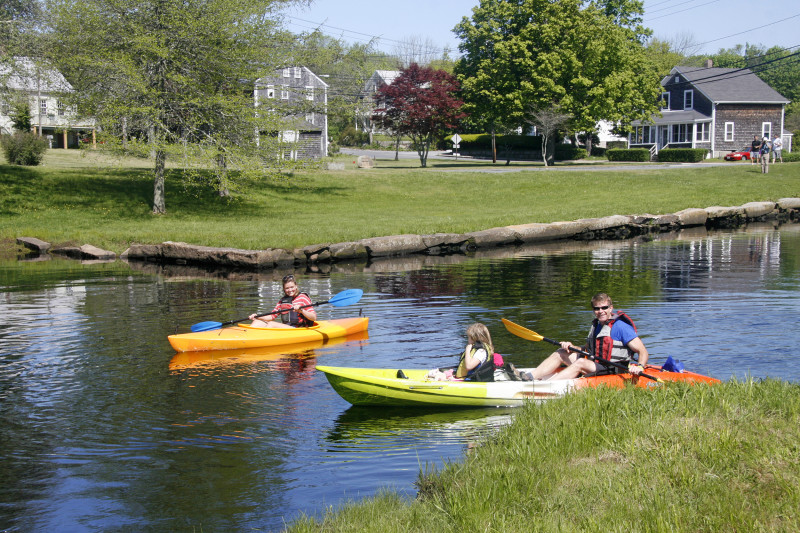
The Head of Westport Town Landing is a perfect spot for paddlers of all ages to launch a kayak to fish from.
1. Head of Westport Town Landing (Westport)
This town boat launch offers both a grassy park for shore fishing and two boat launches, one on each side of the river. And while the Westport River might look peaceful from the surface, under the water it hosts a fishery roiling with different species, including striped bass that swim upstream from Buzzards Bay in the spring and summer.
2. Watuppa Reservation (Westport)
While the vast, 8,500-square-mile Watuppa Reservation contains two large ponds, fishing is prohibited in North Watuppa Pond, as it’s the main water source for the city of Fall River. However, anglers should find abundant large and smallmouth bass, pickerel and yellow perch in Copicut Pond, the easternmost pond in the reserve. If you are fishing here, note that no wading, boating, or swimming is allowed, as Copicut still acts as a buffer for safe drinking water.
3. New Bedford Reservoir (Acushnet)
Every year, thousands of fish swim up the Acushnet River from Buzzards Bay to spawn in the system of four ponds at the New Bedford Reservoir. Sunfish, perch, pickerel, and largemouth bass can be found here year-round. Forming the peaceful headwaters of the Acushnet River, this town-owned property offers an escape from the city where you can explore, relax, and enjoy nature.
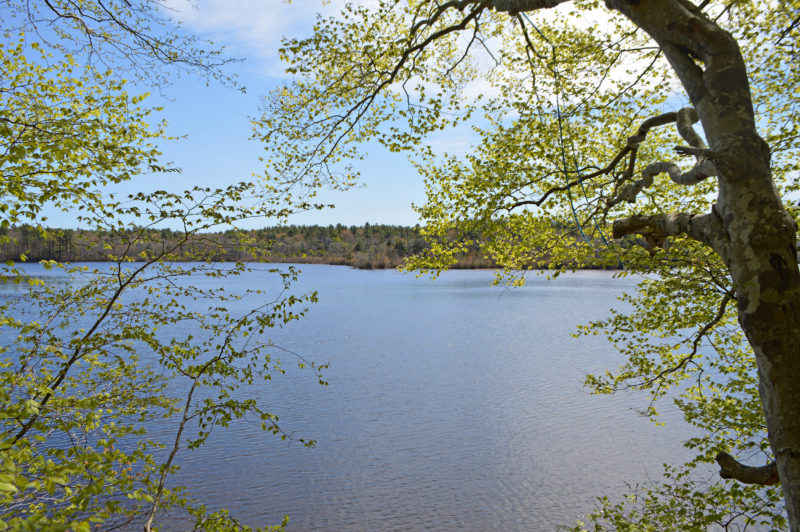
Take in a spectacular view of Assawompset Pond from Betty’s Neck in Lakeville.
4. Betty’s Neck (Lakeville)
Betty’s Neck is one of the few sites that offers public access to Assawompset Pond, the largest natural body of fresh water in Massachusetts. Though no swimming, wading, or boating is allowed here to protect public drinking water, shoreline fishing is permitted on Betty’s Neck, and freshwater anglers can enjoy hours of peaceful fishing for perch, largemouth bass, catfish, and more, including prehistoric-looking pickerel that show up if you stay after dusk. While you’re fishing, keep an eye out for the resident pair of bald eagles that call Assawompset Pond home — and call its aquatic residents dinner!
5. Tripp’s Mill (Mattapoisett)
Part of the growing Mattapoisett River Reserve, Tripp’s Mill is the site of a former sawmill along Tripps Mill Brook, a tributary of the Mattapoisett River. This brook feeds into Tinkham Pond, a calm, grassy pond where bass, sunfish, yellow perch and other species can be found.
6. George E. Wood Memorial Fishermen’s Access Ramp (Rochester)
This small state access ramp provides anglers a spot to launch canoes, kayaks and other small craft into Snipatuit Pond, part of the headwaters of the Mattapoisett River. Largemouth bass, northern pike, pickerel, and yellow perch all swim in these warm, murky waters. While Sniapatuit is small enough that it is easily paddled by a beginner, more advanced anglers can continue down the Mattapoisett River to continue fishing for miles.
7. Mary’s Pond (Rochester)
This glacier-sculpted kettle hole is one of our favorite spots to host learn to fish workshops, with a flat, safe shoreline and shallows perfect for wading with little legs. Mary’s Pond is stocked with trout of all kinds, and also sees largemouth bass and sunfish. Keep an eye on the sky for diving ospreys, who like to come here for fishing as well!
8. Leonard’s Pond (Rochester)
This popular spot close to Mary’s Pond holds the souvenirs of many a fisherman whose swing has gone awry: bobbers that dangle from the trees at the pond’s edge! Mind your swing here, though, and you might come up with bass, sunfish, perch, bluegill, pumpkinseed, or perch. You can access Leonard’s Pond from two public pieces of waterfront on Mary’s Pond Road that bookend a private property.
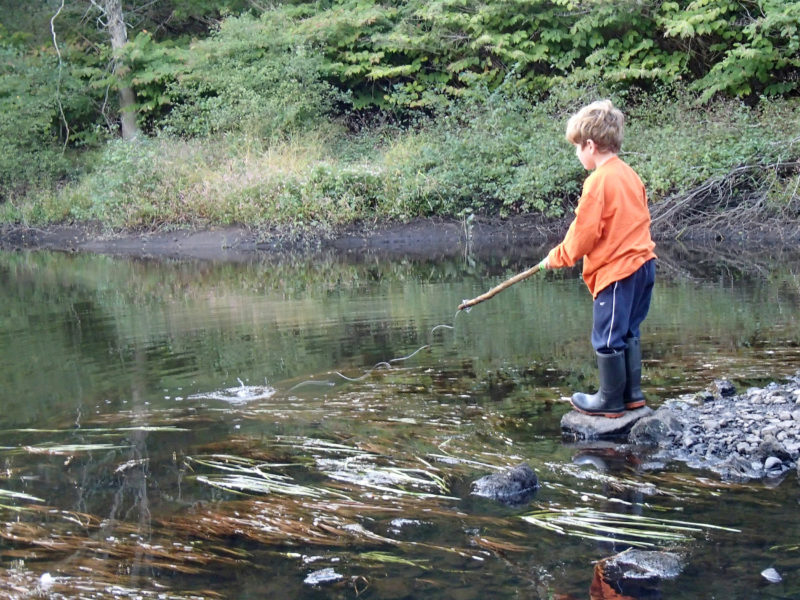
You don’t even need a fancy rod and reel to take your kids fishing – just make your own fishing pole with a stick you find in the woods!
9. Horseshoe Mill (Wareham)
The property at Horseshoe Mill offers a unique access point to Buzzards Bay’s largest freshwater river, the Weweantic: it’s located at the “head of tide,” the spot where fresh water flowing downstream meets salty waters pushed upstream by the tides of Buzzards Bay. As such, it’s home to one of the most diverse migratory fish communities anywhere on the Bay, offering everything from bluefish to perch and schoolies (juvenile striped bass) to spawning rainbow smelt.
10. Big Sandy Pond (Plymouth)
A concrete ramp on Big Sandy Pond’s southeast shore offers a spot for fishermen to launch boats of all kind, from trailered craft to little kayaks. It also offers two miles of sandy shoreline from which to fish for yellow perch, large and small mouth bass, as well as trout that are stocked by the state. Unlike many kettle ponds, Big Sandy Pond is crystal clear, largely free of vegetation to tangle any fisherman’s line – which also makes it a beautiful place to spend the day on the water.
11. Carter Beal Conservation Area (Bourne)
Every spring, you’ll found outdoor enthusiasts congregating around Carter Beal’s fish ladder to watch river herring migrate upstream towards Plymouth’s Great Herring Pond. While recreational fishing for river herring is not legal in the state of Massachusetts, the snaking Herring River mill pond here offers a great place to fish for other species from a kayak or canoe — potentially alongside osprey, heron, or even otter searching for fish themselves.
